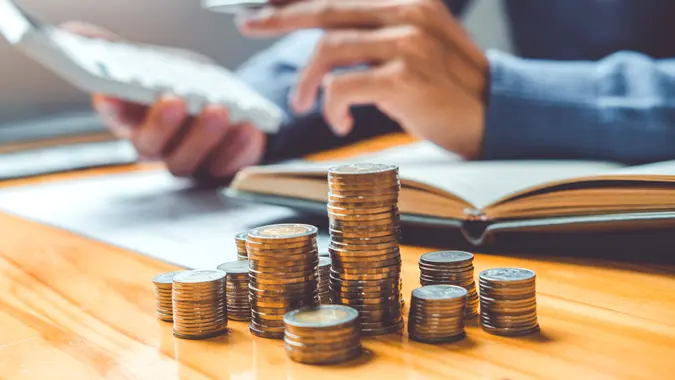Would More Stimulus Checks Offset Increased Costs From Tariffs? Experts Explain

Commitment to Our Readers
GOBankingRates' editorial team is committed to bringing you unbiased reviews and information. We use data-driven methodologies to evaluate financial products and services - our reviews and ratings are not influenced by advertisers. You can read more about our editorial guidelines and our products and services review methodology.

20 Years
Helping You Live Richer

Reviewed
by Experts

Trusted by
Millions of Readers
President Donald Trump has shocked the global market and shaken up the U.S. economy with tariffs that went into effect in April 2025. Businesses across the country are grappling with 145% import duties or higher on goods imported from China and 10% tariffs on items shipped from several other counties. Meanwhile, Americans’ concerns are growing.
The majority of the country thinks the situation is likely to worsen. Over 70% of Americans believe inflated prices will rise even more over the next year, while 75% worry that Trump’s tariffs will spike their cost of living, according to a new study from Allianz Life.
Meanwhile, Elon Musk and his Department of Government Efficiency (DOGE) team have reportedly saved taxpayers $165 billion, per the DOGE website, and has mentioned $5,000 stimulus checks possibly being sent to Americans who qualify.
While PBS News reported that Trump does “love” the idea, there’s been no real movement towards sending them out.
But would a stimulus check help offset increased costs from tariffs? Finance experts weigh in and explain. Also, are these checks likely to get sent out at all?
Short-Term Relief
Stimulus checks could provide short-term relief, but it’s only putting a bandage on the ongoing situation. People who earn less and spend more on household essentials would benefit the most, and, while their spending would help stabilize retail and basic services, overall there are many shortcomings with stimulus checks.
“When it comes to addressing tariff-driven inflation, stimulus checks are a blunt tool,” Michael Schmied, senior financial analyst with Krediteschweiz.ch, explained. “The problem lies in upstream cost pressure, not weak consumer spending.”
Stimulus checks won’t serve as a lasting resource that’s needed to boost the economy for more than a few months.
Case in point: During the COVID-19 pandemic, the U.S. government sent out $1,400 checks to help keep the economy going, but it didn’t last long.
“Consumer spending was strong for about two to three months before tapering off,” said finance expert Andrew Lokenauth. “And that was with much lower inflation than we have now.”
He added, “I worked with a manufacturer in Ohio who saw this firsthand. Their sales spiked 40% the month after checks went out, then dropped back to normal levels within 60 days. The money helped people catch up on bills but didn’t create lasting economic benefits.”
The Financial Downside of Stimulus Checks
Sending out free money might seem like a good idea, but there are financial consequences.
“More stimulus would absolutely increase the [federal] deficit,” Lokenauth said. “Even a modest $1,000 payment to eligible Americans would add roughly $200 billion to federal spending.”
But that’s not the only blowback to stimulus checks. According to Lokenauth, they could make inflation worse.
“I saw this in my consulting work — when millions of consumers suddenly have extra cash, they spend more. This drives up demand and prices, especially when supply chains are already strained. One retailer I advised saw their costs rise 15% after the last round of payments due to increased consumer demand.”
Another negative impact of a stimulus check is dependency and reduced incentives to work.
“One of my manufacturing clients lost eight employees who said the combination of unemployment and stimulus made working less attractive,” Lokenauth said.
The Chances of Stimulus Checks Are Low
While the financial burden of tariffs will fall on companies and consumers, finance experts don’t believe stimulus checks are really on the table, in spite of what Trump and Musk have suggested.
According to Schmied, “The current U.S. administration appears more focused on tax cuts and targeted credits rather than broad direct payments.”
One of the reasons for this is because policymakers are apprehensive to introduce measures that could increase consumer spending too aggressively in an already sensitive economic climate.
“Instead, the focus has shifted to sector-specific support,” Schmied explained. “Relief efforts, such as tariff credits and incentives, are being directed toward industries like automotive manufacturing — pointing to a preference for targeted tools over general stimulus checks.”
With inflation being a big concern, politicians are turning their attention to other measures that wouldn’t be as risky and rock the economy even more.
“The political appetite just isn’t there for stimulus checks,” Lokenauth said. “I’ve talked with a couple Congressional staffers who made it clear their bosses have zero interest in additional direct payments — they’re focused on reducing inflation, not adding fuel to it.”
Alternative Options
If stimulus checks aren’t an option, there are other ways to help relieve the financial hardship of tariffs.
“Targeted tax relief measures — such as payroll tax reductions or industry-specific credits — are stronger alternatives,” Schmied explained. “These tools can deliver financial support without the broad fiscal footprint of universal payments.”
Subsidies or expanded unemployment benefits could cushion the impact for the most exposed groups.
“These focused approaches offer a more controlled and sustainable way to respond to rising tariff costs,” Schmied added.
Final Thoughts
With inflation and tariffs combining to pressure Americans’ finances, relief is needed, but temporary solutions aren’t viable. Programs that lift up lower income families and offer assistance with utility bills or food costs deliver better results per dollar spent.
“The real solution lies in addressing the root causes: modernizing our trade policies, investing in domestic manufacturing and improving supply chain resilience,” Lokenauth said.
Stimulus payments aren’t effective and could actually create more problems.
“It’s like treating the symptoms while ignoring the disease,” Lokenauth. “We need to focus on long-term solutions, even if they’re politically harder to sell.”
Editor’s note on political coverage: GOBankingRates is nonpartisan and strives to cover all aspects of the economy objectively and present balanced reports on politically focused finance stories. You can find more coverage of this topic on GOBankingRates.com.
More From GOBankingRates
Sources
- Allianz, “Allianz Life Study Finds Inflation and Tariffs Increasingly Worrying Americans.”
- PBS News, “Could Trump really give money from Musk’s DOGE cuts to taxpayers?“
- Michael Schmied, Krediteschweiz.ch
- Andrew Lokenauth
 Written by
Written by  Edited by
Edited by 

























